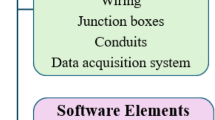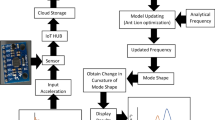Abstract
It is the right time to embark upon wireless sensor networks to overcome problems of the structures safety by analyzing them precisely using structural health monitoring techniques. This research lays emphasis on the development of an IOT based smart instrumentation for analyzing the health structure based on simple accelerometer (ADXL320) and MCU node. The accelerometer sensing paves way in determining the health structure by observing the non-linear vibrations in the structure. The real-time data acquired from the sensor is transmitted to a cloud platform (Thingspeak) using a secure API communication that helps client to observe the frequency response of the entire structure remotely. The developed instrumentation is a power efficient, low cost solution having a latency of 15 s, and remarkably efficient.



Similar content being viewed by others
References
Shah, A. A., Chowdhry, B. S., Daudpoto, J., & Ali, I. (2018). Transient structural health monitoring of the test bridges using finite element method. In: 2018 5th International multi-topic ICT conference (IMTIC) (pp. 1–7).
Farrar, C. R., & Lieven, N. A. J. (2007). Damage prognosis: the future of structural health monitoring. Philosophical Transactions of the Royal Society A: Mathematical, Physical and Engineering Sciences, 365(1851), 623–632.
Bangerth, W., & Joshi, A. (2008). Adaptive finite element methods for the solution of inverse problems in optical tomography. Inverse Problems, 24(3), 34011.
Ali, S., Shaikh, F. K., Chowdhry, B. S., & Felemban, E. (2014). Smart structural monitoring—A case of bridge damage detection. In: 2014 4th International conference on wireless communications, vehicular technology, information theory and aerospace & electronic systems (VITAE) (pp. 1–5).
Pimentel, R. M. da C. M., et al. (2008). Hybrid fiber-optic/electrical measurement system for characterization of railway traffic and its effects on a short span bridge. IEEE Sensors Journal, 8(7), 1243–1249.
Russ, J. C. (2016). The image processing handbook. Boca Raton: CRC Press.
Kim, S., Lee, J., Park, M.-S., & Jo, B.-W. (2009). Vehicle signal analysis using artificial neural networks for a bridge weigh-in-motion system. Sensors, 9(10), 7943–7956.
Chowdhry, B. S., Shah, A., Uqalili, M., & Meharan, J. P. G. (2018). Design of low-cost smart catś eye reflector device for damage identification of a bridge. In: Global wireless summit (GWS) (pp. 256–259).
Martínez-Casas, J., Giner-Navarro, J., Baeza, L., & Denia, F. D. (2017). Improved railway wheelset-track interaction model in the high-frequency domain. Journal of Computational and Applied Mathematics, 309, 642–653.
Shah, A. A., Chowdhry, B.S., & Bhatti, A. K. (2018). Resonance frequency detection using accelerometer of a test bridge. International Journal of Latest Engineering and Management Research, 3(7), 72–74.
Fraga-Lamas, P., Fernández-Caramés, T., & Castedo, L. (2017). Towards the Internet of smart trains: A review on industrial IoT-connected railways. Sensors, 17(6), 1457.
Hatzivasilis, G., Papaefstathiou, I., & Manifavas, C. (2017) Real-time management of railway CPS secure administration of IoT and CPS infrastructure. In: 2017 6th Mediterranean conference on embedded computing (MECO) (pp. 1–4).
Ray, P. P. (2018). A survey on Internet of Things architectures. Journal of King Saud University-Computer and Information Sciences, 30(3), 291–319.
Chellaswamy, C., Balaji, L., Vanathi, A., & Saravanan, L. (2017). IoT based rail track health monitoring and information system. In: International conference on microelectronic devices. Circuits and systems (ICMDCS) (pp. 1–6).
Harak, S. S., Ravi, S. K., Sharma, S. C., & Harsha, S. P. (2015). Effect of vertical track irregularities on the dynamics of freight railway wagon. International Journal of Vehicle Noise and Vibration, 11(2), 133–148.
Moses, F. (1979). Weigh-in-motion system using instrumented bridges. Journal of Transportation Engineering, 105(3), 233–249.
Bernal, D. (2013). Kalman filter damage detection in the presence of changing process and measurement noise. Mechanical Systems and Signal Processing, 39(1–2), 361–371.
Yang, J. N., Lin, S., Huang, H., & Zhou, L. (2006). An adaptive extended Kalman filter for structural damage identification. Structural Control and Health Monitoring: The Official Journal of the International Association for Structural Control and Monitoring and of the European Association for the Control of Structures, 13(4), 849–867.
Kessler, S. S., Spearing, S. M., Atalla, M. J., Cesnik, C. E. S., & Soutis, C. (2002). Damage detection in composite materials using frequency response methods. Composites Part B: Engineering, 33(1), 87–95.
Schulz, P., et al. (2017). Latency critical IoT applications in 5G: Perspective on the design of radio interface and network architecture. IEEE Communications Magazine, 55(2), 70–78.
Acknowledgements
The proposed instrumentation was developed, and tested in NCRA-CMS lab of Mehran University of Engineering and Technology, Jamshoro, Pakistan.
Author information
Authors and Affiliations
Corresponding author
Additional information
Publisher's Note
Springer Nature remains neutral with regard to jurisdictional claims in published maps and institutional affiliations.
Rights and permissions
About this article
Cite this article
Chowdhry, B.S., Shah, A.A., Uqaili, M.A. et al. Development of IOT Based Smart Instrumentation for the Real Time Structural Health Monitoring. Wireless Pers Commun 113, 1641–1649 (2020). https://doi.org/10.1007/s11277-020-07311-4
Published:
Issue Date:
DOI: https://doi.org/10.1007/s11277-020-07311-4




